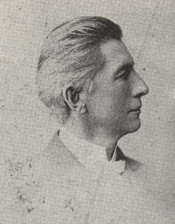Charles G. Conn
Charles G. Conn | |
|---|---|
 | |
| Member of the U.S. House of Representatives from Indiana's 13th district | |
| In office March 4, 1893 – March 4, 1895 | |
| Preceded by | Benjamin F. Shively |
| Succeeded by | Lemuel W. Royse |
| Member of the Indiana House of Representatives for Elkhart, Noble, and DeKalb | |
| In office January 10, 1889 – January 8, 1891 | |
| Preceded by | William M. Van Slyke |
| Succeeded by | Norman Teal |
| Personal details | |
| Born | January 29, 1844 1st Michigan Volunteer Sharpshooters Regiment |
| Battles/wars | American Civil War |
Charles Gerard Conn (January 29, 1844 – January 5, 1931) was an entrepreneur, band instrument manufacturer, newspaper publisher, and U.S. Representative from Indiana for one term from 1893 to 1895.
Biography
Early life and education
Charles Gerard Conn was born in
Civil War
With the outbreak of the
Career
After the war he engaged in the grocery and bakery business. In 1871, while serving as a band leader in Buchanan, Michigan, Conn badly injured his hand while working at the local zinc horse collar-pad factory.[1] The accident forced Conn to switch from violin to cornet.
In 1877, Conn and his wife, Catherine, relocated to
Charles Conn was elected Mayor of Elkhart in 1880.
In 1880, Conn was elected Mayor of Elkhart on the Democratic ticket. He was re-elected in 1882 but did not finish the term. Ten days before the general election in 1888, Conn was drafted as an emergency Democratic candidate for the Indiana House of Representatives, and won the election.
Conn founded a newspaper, the Elkhart Daily Truth, on 15 October 1889, which is still operating as The Elkhart Truth.[3] He published the monthly Trumpet Notes which he circulated amongst his employees and dealers. He also published a scandal sheet called The Gossip which, along with the town doings, he used occasionally to attack his competitors and enemies.
Congress
Conn was elected as a
Later career
In 1915 Conn's growing debt crisis forced him to seek a buyer for his assets, and all of Conn's holdings were bought by a group of investors led by Carl Dimond Greenleaf, whom Conn had met during his years in Washington, D.C., and invested in some grain mills in Ohio which Greenleaf owned. Initially Conn held onto ownership of The Elkhart Truth, but a few months after the sale of his other holdings, Conn sold The Elkhart Truth to Greenleaf and local entrepreneur Andrew Hubble Beardsley.
Retirement and death
The sale of Conn's holdings was detrimental to his marriage, and he and his wife Kate divorced. In 1916 Conn retired and moved to
Conn authored books in his retirement, including The Sixth Sense, Prayer: Brain Cell Reformation (1916), For the Good of the World. Finding the Real God (1919), and The Wonder Book: How to Achieve Success (1923). Conn died on January 5, 1931, in Los Angeles, and was interred in Grace Lawn Cemetery, Elkhart, Indiana.[4] Once a very wealthy and influential man, he died almost penniless. His estate didn't have enough money in it to afford a grave marker, and a hat was passed around the horn factory to collect enough money to buy one.
Mrs. Conn was permitted to remain in the Conn's Elkhart home, the Charles Gerard Conn Mansion, where she lived until her death in 1924. The mansion was added to the National Register of Historic Places in 2007.[5]
See also
- C.G. Conn
References
Notes
- ^ a b c d Banks, Margaret Downie (Ph.D.), Senior Curator of Musical Instruments, National Music Museum. "A Brief History of the Conn Company (1874–present)". Vermillion, South Dakota. Archived from the original on 25 January 2012. Retrieved 22 February 2012.
{{cite web}}: CS1 maint: multiple names: authors list (link) - ^ Ksander, Yaël (15 September 2008). "Conn Instruments". Retrieved 22 February 2012.
- ^ Banks, Margaret Downie (Ph.D.), Senior Curator of Musical Instruments, National Music Museum. "Col. Conn's Journalistic and Political Pursuits (1889–1897)". Vermillion, South Dakota. Archived from the original on 25 January 2012. Retrieved 22 February 2012.
{{cite web}}: CS1 maint: multiple names: authors list (link) - ^ "Conn, Charles Gerard, (1844–1931)". Biographical Directory of the United States Congress. Retrieved 22 February 2012.
- ^ "National Register Information System". National Register of Historic Places. National Park Service. July 9, 2010.
Sources
- United States Congress. "Charles G. Conn (id: C000683)". Biographical Directory of the United States Congress. Retrieved on 2009-03-31
![]() This article incorporates public domain material from the Biographical Directory of the United States Congress
This article incorporates public domain material from the Biographical Directory of the United States Congress


